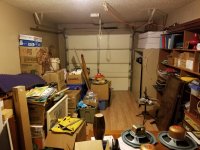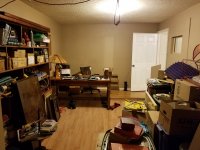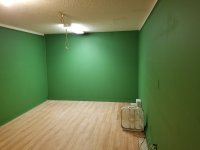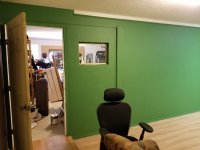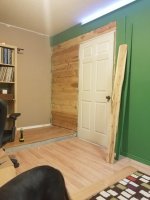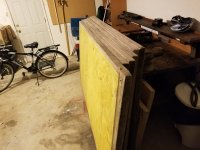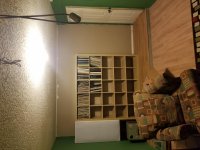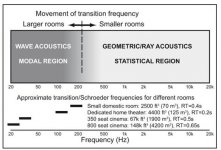According to Linkwitz dipole subs can be better than monopoles because they excite fewer room modes, I'm wondering also whether because they radiate primarily in opposite directions if that is also an advantage and if they almost act as two in one, or is it just wishful thinking on my part? 

Attention DIYers: the whole issue of what to do about that out of phase rear wave has been hijacked by commercial interests who, of necessity, are best off if they sell boxes. Likewise for the sub forum, it is as if there are no good solutions except boxes fulfilling the model Thiele advanced.According to Linkwitz dipole subs can be better than monopoles because they excite fewer room modes, I'm wondering also whether because they radiate primarily in opposite directions if that is also an advantage and if they almost act as two in one, or is it just wishful thinking on my part?
Think statistically. Better to say the eigentones (and box resonances) are always lurking, just a matter of how much the speaker activates them. As long as the rear wave does not uniformly conflict with the front wave in a wide band, it is not an inimical presence.
An irregular-shaped large baffle (or long Vogt tube, Transmission-line-like path, or real big sequestration) meets that stricture and you've got great sound.
But for a smallish dipole baffle, you need Linkwitz' naive-model math, vast bass boost, and luck.
B.
Last edited:
An irregular-shaped large baffle (or long Vogt tube, Transmission-line-like path, or real big sequestration) meets that stricture and you've got great sound.
B.
Can you please expound? I think I understand (rear wave does not uniformly conflict with the front wave) but would like to confirm. Contemplating a TL HT sub. Planning on running it near field on back of sofa.
To avoid irritating those who ardently believe in the Theory of TL as Taught Us by MJK, I'll only say that when the exit door of the tube is remote from the driver, you have a welcome benefit of having the exiting wave more randomly interacting with the driver front-wave.Can you please expound? I think I understand (rear wave does not uniformly conflict with the front wave) but would like to confirm. Contemplating a TL HT sub. Planning on running it near field on back of sofa.
Seems like an important consideration in building a TL, eh. Like Nelson Pass's beautiful article, I've been thinking about a folded Vogt tube about 15 feet long. The folds have to be an even-number so that the exit is remote from the driver. Call it Bentoronto's TL Theorem.
B.
Can you please expound? I think I understand (rear wave does not uniformly conflict with the front wave) but would like to confirm.
Do you mean OB/dipole? There is some cancellation at lower frequencies depending on baffle width and shape. Less at higher frequencies as they become more directional and with reflections the output can be greater than a monopole
John does say this with regard to the DC mode.. I can't see the issue. When a wavelength fits in the room, different parts of the room will be at opposite pressures so what does room pressurisation mean.. that the room is elevated in pressure in a spatially consistent manner? At lower frequencies this just means the bass is being produced. If the room keeps it in, this is just a simple resonance. Its level can be adjusted like any other resonance.whether this method also means the room is not pressurised?
I used the words "conflict" and "band". While phase isn't usually relevant to hearing, it is definitely relevant to acoustics. If the baffle is uniform (textbooks might use circular baffles) and you are close to Darth Vader phase, you get some degree of annihilation. Otherwise, the annihilation is conditional, esp if the rear wave has bounced around some.Do you mean OB/dipole? There is some cancellation at lower frequencies depending on baffle width and shape. Less at higher frequencies as they become more directional and with reflections the output can be greater than a monopole
That same logic applies to all boxes where the rear wave comes loose to attack the front wave. In a BR box, the rear wave coming out of the port annihilates the front wave below the box tuning*. That's why a BR box whimpers away at low freq at 18db/8ave.
I think some folks on this forum who have never used a dipole sub (but who remember how long a sound wave is) think every note below 500 Hz is totally annihilated.
B.
*the port output is copacetic with the front wave above the tuned freq
Last edited:
John does say this with regard to the DC mode.. I can't see the issue. When a wavelength fits in the room, different parts of the room will be at opposite pressures so what does room pressurisation mean.. that the room is elevated in pressure in a spatially consistent manner? At lower frequencies this just means the bass is being produced. If the room keeps it in, this is just a simple resonance. Its level can be adjusted like any other resonance.
Linkwitz refers to a dipole as a velocity source and a monopole as a pressure source. Here is a quote from a response comparison Dipole-monople response
" Since a dipole source consists really of two spaced monopole sources of opposite polarity, it generates a large particle velocity between them and a local acoustic field impedance (p/v) which varies with observation point, and which is generally lower than that for a single monopole. Is our hearing in some way sensitive to sound field impedance? Does it affect coupling to the ear canal? Certainly a dipole in a room, at the same location as a monopole, couples to a different degree to the same room mode."
Room modes have regions of pressure and regions of velocity. I don't believe that's it. Probably the more interesting thing about dipoles is they have directivity.
I think their directivity is the largest factor, I was thinking also that they are effectively two sources in one speaker, which that quote above also seems to suggest
Been thinking about this and I'm still not sure there is any more in it. I think the pressure spread in space creates directivity and that's what I see the quote as saying. By comparison, the monopole as a single pressure point creates velocity toward the space all around it.
I used to run dipole bass. This was long before I learned to control room modes so I am struggling for a comparison (e.g. the definition of 'dipole sound') but I suspect that once they are fixed the two system types should come together in how they sound.
I used to run dipole bass. This was long before I learned to control room modes so I am struggling for a comparison (e.g. the definition of 'dipole sound') but I suspect that once they are fixed the two system types should come together in how they sound.
Perhaps there are some answers here regards room gain and what pressurisation may mean. room gain in case of dipole woofer?
Hi Guys, it's me, the original poster. Since I started this thread we moved twice and the second time was from Michigan to Albuquerque New Mexico two years ago. We bought a house with a three car garage. we used the third stall for storage as it was walled off when we bought the place.
4 months ago I decided to turn that stall into my listening space so I emptied the room, screwed the garage door to the wall and removed the garage door rails. I built a false wall and insulated it and dry walled it.
Then I painted the room except the back wall because I was going to put my LP shelf there and surround it will bass traps.
After looking at the back wall I decided to move the door as it was right where a good bass trap could go.
So I asked, in the first post, where I should use bass traps for multiple subs and after reading all these good threads I decided to do both.
I now have 4 subs and super chuck traps for the front corners and the back corners.
I hope to finish up the room this weekend and start moving my system in.
Thanks for all the great discussion and advice.
Dennis.
4 months ago I decided to turn that stall into my listening space so I emptied the room, screwed the garage door to the wall and removed the garage door rails. I built a false wall and insulated it and dry walled it.
Then I painted the room except the back wall because I was going to put my LP shelf there and surround it will bass traps.
After looking at the back wall I decided to move the door as it was right where a good bass trap could go.
So I asked, in the first post, where I should use bass traps for multiple subs and after reading all these good threads I decided to do both.
I now have 4 subs and super chuck traps for the front corners and the back corners.
I hope to finish up the room this weekend and start moving my system in.
Thanks for all the great discussion and advice.
Dennis.
Attachments
Last edited:
Watch this segment by Geddes. You might be damping your high frequencies without damping your low frequencies. IOW, the type of low frequency room treatments one uses might be harmful.
Earl Geddes on Multiple Subwoofers in Small Rooms - YouTube
<iframe width="560" height="315" src="https://www.youtube.com/embed/SCWL-zusyqw?start=935" frameborder="0" allow="accelerometer; autoplay; encrypted-media; gyroscope; picture-in-picture" allowfullscreen></iframe>
Earl Geddes on Multiple Subwoofers in Small Rooms - YouTube
<iframe width="560" height="315" src="https://www.youtube.com/embed/SCWL-zusyqw?start=935" frameborder="0" allow="accelerometer; autoplay; encrypted-media; gyroscope; picture-in-picture" allowfullscreen></iframe>
Thanks for the link Bradley. Here is the back of the room
I moved the door so I can put bass traps in both corners. I am building doors for the record shelf made of QRD diffusers so the room won't be real dead and I am only putting absorbers at the first reflection point.
I moved the door so I can put bass traps in both corners. I am building doors for the record shelf made of QRD diffusers so the room won't be real dead and I am only putting absorbers at the first reflection point.
Attachments
Low frequency wavelengths are very long and our brains are very slow so low frequencies bounce around the room several times before we hear them. Consequently, first reflection points are only relevant to frequencies above the transition region.
Bass treatment is always good, but only if you do good bass treatment. That's the tricky part. If you do bad bass treatment you harm your highs without getting benefit in your lows. Good bass treatment means the wall structure itself is the treatment. You have to rip walls and ceilings down to do it.
Someone else in the forum mentioned you might be sitting in a single listening location in your room. If that's true your bass management is a lot easier. For only one listening location you can use a single sub optimized for that single location. It only gets more complex when you want to create a larger listening area.
If you decided you wanted a larger listening area for you and your friends then you'd use the multi-sub designs/digital signal processing/ripping down and rebuilding walls option. I was wrong to tell you about the complex methods initially because I didn't pay attention to what you were actually doing.
Single listening location = one sub, optimized for that one listening spot. Easy with high satisfaction.
Wide listening area = multi-subs, computer algorithms, digital signal processing, etc. Difficult with lots of frustration.
Bass treatment is always good, but only if you do good bass treatment. That's the tricky part. If you do bad bass treatment you harm your highs without getting benefit in your lows. Good bass treatment means the wall structure itself is the treatment. You have to rip walls and ceilings down to do it.
Someone else in the forum mentioned you might be sitting in a single listening location in your room. If that's true your bass management is a lot easier. For only one listening location you can use a single sub optimized for that single location. It only gets more complex when you want to create a larger listening area.
If you decided you wanted a larger listening area for you and your friends then you'd use the multi-sub designs/digital signal processing/ripping down and rebuilding walls option. I was wrong to tell you about the complex methods initially because I didn't pay attention to what you were actually doing.
Single listening location = one sub, optimized for that one listening spot. Easy with high satisfaction.
Wide listening area = multi-subs, computer algorithms, digital signal processing, etc. Difficult with lots of frustration.
Attachments
The first reflection point I'm doing is only for the highs. It was just a mention. I have two subs in the front corners with superchuck bass traps on top of them up to the ceiling. In the back of the room I have two subs in the up against the back wall and a foot in from the side wall. those are sided by 8" thick bass traps that go up to the ceiling and across the top of the record shelf. There is about 6" of space behind them.
I only have one seat in the room but as an old bass player, 4 subs is what I wanted to ensure good low end response with the added benefit of leveling the signal around the room.
I only have one seat in the room but as an old bass player, 4 subs is what I wanted to ensure good low end response with the added benefit of leveling the signal around the room.
- Home
- Loudspeakers
- Subwoofers
- Multiple subs vs. bass traps

